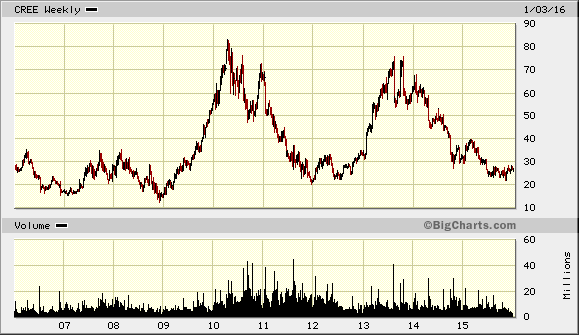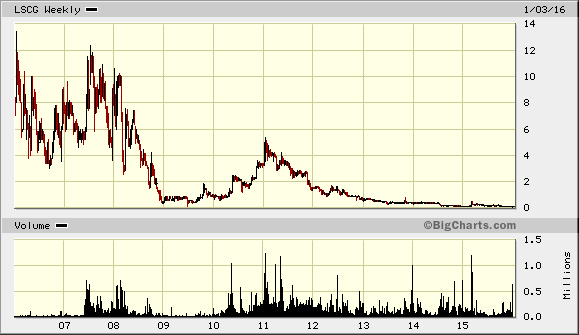One thing growth investors and stock promoters love is a brand new industry that is growing quickly and revolutionizing our lives. The problem is most of the time much of the companies end up losing money and even going bankrupt even as the new industry blossoms because of fierce competition. This happened with railroad companies in Britain in the mid 1800s, electronics companies in the US in the 1960s, computer companies in the 1980s, internet companies during the tech bubble in 1999, and has happened over the last few years in LEDs and solar panels. In most of these cases most companies did poorly and there were only a few companies that came to dominate the industry or if there were no good barriers to entry or many competing technologies, cutthroat competition has continued. Most of these stories have been told before and better than I could tell. So I will concentrate on the LED industry which is one I know well and has not been well followed by most people.
Light emitting diodes (LEDs) have been around for decades but only in the last decade have there been improvements in the technology such that they could be used in normal lighting situations rather than just as indicator lights. The first LED light bulb I bought back in 2008 produced 200 lumens of bluish-white light (~7000k). For comparison, 800 lumens is what a standard 60-watt incandescent bulb produces. That bulb was made by Lighting Science Group Corp (LSCG) and cost about $50. The most recent LED bulbs I bought (made by GE and sold at Home Depot) cost $3.13 each and produce 760 lumens or warm white light (2700k).
I just finished converting my house entirely to LEDs. The light quality is as good as incandescent bulbs, they use much less electricity, and they stay cool (which means less chance of fires and lower air conditioner usage). They also on average last far longer. The problem for manufacturers of LEDs is that no manufacturers have technology that is vastly superior to the others or patents on essential technologies. So while LEDs are high-tech, producing them is a brutal business. There are a handful of large manufacturers of the actual LEDs (e.g., Seoul Semiconductor, Epistar, Cree, Philips, Osram, and others) while there are thousands of companies putting those LEDs together with the electronics to drive them in bulbs. The large producers make a normal profit but most of the producers of LED bulbs make little.
Here is a chart of CREE, one of the ‘winners’:

Cree has done well but the company’s stock is where it was essentially a decade ago.
Here is the chart of one of the losers, Lighting Science Group (LSCG):

Lighting Science of course was my most profitable short ever back in 2008. Even though the company did go on to successfully market its products, they have not been profitable because of lower-cost competition.
LED lights are pretty awesome and within a decade 90% of new fixtures will use them. In two decades’ time LEDs will have 99%+ market share in general lighting for home and industry. Besides their aforementioned advantages, their unique properties also have made it possible for many of the poorest in the world to use a small solar cell and battery to power LED lights and charge phones, reducing the use of kerosene lamps and resulting in cleaner air and better health.
Why bring this up now? I am really excited about CRISPR-Cas9 and have publicly said that I would love to invest in any company in that space. Editas (EDIT) just filed an S-1 prospectus to go public. Anyone who is in awe of the possibilities of this gene editing technique including myself would do well to consider the similarities to past highly-hyped new industries. That is not even considering the legal morass that CRISPR is in right now with multiple groups having filed competing patents.
Disclaimer: No positions in any stocks mentioned. I have no relationship with any other parties mentioned above. This blog has a terms of use that is incorporated by reference into this post; you can find all my disclaimers and disclosures there as well.
(By the way, if you are looking to get a large number of non-standard LED lights (such as T-8 lights), I recommend Chong Ming LED — I found them through Alibaba and purchased 180 T-8 tube lights for an LED retrofit at the daycare run by my church. I also highly recommend Hyperikon, which has a large selection of bulbs available on Amazon.)
Love your posts, but let me offer a rebuttal to your list of advantages of LED bulbs (I’m as thrifty and as pro-efficiency as anyone I know, by the way, but just happen not to like LED lighting for the reasons outlined below):
1) “The light quality is as good as incandescent bulbs” This is clearly subjective, but I’ve tried five different brands, and none of them produce anything I would have difficulty distinguishing from incandescent light. They have indeed improved over time, but the light is still much closer to that of a CFL than that of an incandescent bulb. Objectively, the CRI (color rendering index) ratings for most LEDs are still in the low 80s (out of 100).
2) “and they stay cool (which means less chance of fires and lower air conditioner usage)” I have not tested the GE bulb you own specifically, but all the ones I have tested (Cree, Philips, etc.) get tremendously hot. Additionally, instead of the heat being spread throughout a glass surface, it is concentrated in the metal portion of the bulb. If you let an LED heat up fully, then unplug it for five minutes, then unscrew the bulb while touching the metal at all…a trip to the ER is not out of the question. That’s how hot they get (and remain after turning off). Many models are not approved to be used in enclosures. This is because of the heat concentration problem (fire hazard), and (mostly) because the components tend to fail under high heat (more below).
3) “They also on average last far longer. ” In theory, yes. In practice, no way. The failure rates are very high for LED bulbs (even when used in an ideal environment), which offsets the fact that they last longer when they do not fail. I know this from personal experience (many brands, many diff. manufacturing batches) and from reviews. It’s much worse in my opinion to have a product that will fail randomly starting immediately, than one will will work 99% of the time for the next 2 years and then fail 100% of the time. The other thing is that even if the bulb doesn’t fail, it will dim over time. LED light output is not a binary thing, so five years from now you might not have the illumination you need.
4) They are much heavier and sometimes larger than the incandescent bulbs they replace. In plenty of applications, this is a big deal.
Hopefully all of these issues will be worked out over time (like any other new tech). I just felt compelled to give the consumer bear case. Personally, I use a few LEDs, but mostly am sticking with incandescents for now.
1) If going by CRI there are now lots of LED bulbs with CRI at 90 or above (such as 800 lumen bulbs for $3 each at Costco).
2) Yes they get hot. You are of course correct that most can’t be put in completely enclosed fixtures. Any fire risk is much less than incandescent bulbs because of the far lower total heat generated and lower wattage (so risk of electrical fire is reduced as well). The maximum temperature of the bulb only matters if it is in direct contact with a flammable substance. As manufacturers gain experience with making LEDs maximum bulb temperatures drop. For example, the heat sink temperature on a 450 lumen Cree bulb (previous generation) in a 4-bulb open lighting fixture attached to a ceiling fan in my office is 207 F. The heat sink temperature on the 450 lumen Philips bulb (current generation) is 172 F (similar to surface temperature of a 60w incandescent).
3) I’ve had plenty of incandescent bulbs die young as well. LED lifetimes are greatly exaggerated but I’ve definitely averaged over 5,000 hours on my most-used bulbs and probably closer to 10,000 hours. And I would rather have a bulb fail by dimming rather than just going out — it is sort of a fail-soft, rather than being plunged into darkness.
4) They are often somewhat larger but I
Michael,
You may be right about CRISPR, I have been studying the field for a while (I mean actually taking classes) to learn much more about it, but there are already other go arounds for the initial discovery of the editing technique. That being said, I still believe there are going to be major opportunities in the field of synthetic biology over the next 2-3 decades because you can patent organisms or logic gates and we could see “libraries” of logic functions as there are in computer design like for qualcom etc. We also don’t know yet who is going to emerge as the premier software for the design of said genetic circuits and so on. What are your thoughts on Ginko Bioworks? We also have a lot of issue with cloning, etc.
I am not at all familiar with Ginko.